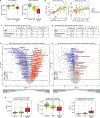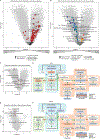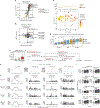Linking microbial genes to plasma and stool metabolites uncovers host-microbial interactions underlying ulcerative colitis disease course
- PMID: 38215740
- PMCID: PMC10923022
- DOI: 10.1016/j.chom.2023.12.013
Linking microbial genes to plasma and stool metabolites uncovers host-microbial interactions underlying ulcerative colitis disease course
Abstract
Understanding the role of the microbiome in inflammatory diseases requires the identification of microbial effector molecules. We established an approach to link disease-associated microbes to microbial metabolites by integrating paired metagenomics, stool and plasma metabolomics, and culturomics. We identified host-microbial interactions correlated with disease activity, inflammation, and the clinical course of ulcerative colitis (UC) in the Predicting Response to Standardized Colitis Therapy (PROTECT) pediatric inception cohort. In severe disease, metabolite changes included increased dipeptides and tauro-conjugated bile acids (BAs) and decreased amino-acid-conjugated BAs in stool, whereas in plasma polyamines (N-acetylputrescine and N1-acetylspermidine) increased. Using patient samples and Veillonella parvula as a model, we uncovered nitrate- and lactate-dependent metabolic pathways, experimentally linking V. parvula expansion to immunomodulatory tryptophan metabolite production. Additionally, V. parvula metabolizes immunosuppressive thiopurine drugs through xdhA xanthine dehydrogenase, potentially impairing the therapeutic response. Our findings demonstrate that the microbiome contributes to disease-associated metabolite changes, underscoring the importance of these interactions in disease pathology and treatment.
Keywords: Veillonella parvula; culturomics; metabolomics; metagenomics; microbiome; multiomics data integration; nitrate respiration; thiopurines; tryptophan metabolism; ulcerative colitis.
Copyright © 2023 Elsevier Inc. All rights reserved.
Conflict of interest statement
Declaration of interests R.J.X. is a co-founder of Celsius Therapeutics and Jnana Therapeutics, board director at MoonLake Immunotherapeutics, and consultant to Nestlé. D.R.M. is a co-founder of MedBiome Inc.
Figures






References
MeSH terms
Grants and funding
LinkOut - more resources
Full Text Sources
Other Literature Sources
Medical

